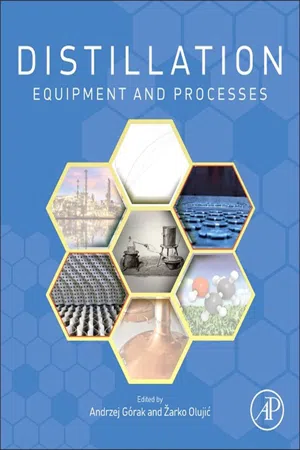1.1. Introduction
Distillation operations are carried out in columns, that is, cylindrical pressure vessels with large height to diameter ratios, containing various kinds of internals chosen and arranged appropriately to enable cost-effective separation of binary or multicomponent, mainly liquid, feed mixtures into desired pure products or specified fractions.
As mentioned by Stichlmair and Fair in the preface of Distillation—Principles and Practice, which focuses on understanding of the principles and their translation into basic design practices, distillation columns are the workhorses of the petroleum, petrochemical, chemical, and related process industries [1]. A complementary, more pragmatic view is given by Kister in Distillation Design, with emphasis on the practical aspects and reliability as encountered and required during the design of distillation columns [2].
The outgoing point for design of a new distillation column is the top and/or bottom product specification (required purity and/or recovery) for a given feed mixture, with known composition, flow rate, and thermal state at a given pressure and temperature. Upon choosing the operating pressure and assuming column pressure drop, detailed column performance calculations deliver optimum stage and reflux requirements, all based on appropriate vapor–liquid equilibrium data. The next, column dimensioning step is concerned with determining column diameter(s) and height for the chosen type of vapor–liquid contacting device. Critical positions are the top and bottom stage of rectification and stripping sections, and the column shell diameter is usually based on the stage with the maximum vapor load; and to complete the design calculations properly, one or more iterations on pressure drop are required.
Upon completing stage and reflux requirement calculations, the internal flow rates of vapor and liquid as well as corresponding values of relevant physical properties (densities and viscosities of two phases and surface tension) are known per stage and serve as the basis for the determination of column diameter(s). However, the number of theoretical plates or equilibrium stages, which is by definition the number of times the mass transfer equilibrium has to be established between ascending vapor and descending liquid streams above and below the feed to achieve desired separation, cannot be directly translated into column height. Namely, along an operating distillation column the equilibrium between vapor and liquid is never fully established. The column height required to produce the degree of mass transfer equivalent to the given number of equilibrium stages will depend on the type and performance characteristics of equipment (internals) chosen to generate interfacial area, that is, to enable mass transfer to occur so that for each component the required number of moles is transported accordingly, from vapor to liquid and reverse within the contact time available.
1.1.1. Distillation column anatomy (internal structure)
Regarding the equipment used to promote intimate contact of ascending vapor and descending liquid in a distillation column or tower, a distinction is generally made between plate or tray columns and packed columns, and in the case of the latter, between randomly and orderly packed columns, that is, random and structured packings.
Figure 1.1 shows schematically a distillation column shell containing all relevant equipment as employed in packed and/or trayed columns. From the top to the bottom: (1) a demister, i.e. a device for removal of entrained droplets from the vapor leaving the column through the nozzle at the top of the column; a liquid distributor (2) irrigating a randomly packed bed (3) laying on a V-shaped support plate (4). One should note that normally a hold-down plate (hard to see here) is used to prevent bed expansion in an upward direction due to pressure upsets during operation.
The liquid leaving the randomly packed bed is collected in a chevron (vane)-type liquid collector (5), where it is mixed with the liquid feed entering through a nozzle at the side of the column. The mixed liquid enters via a down pipe the liquid distributor (2), irrigating a bed consisting of two different sizes of a corrugated sheet structured packing (6), supported by a support plate (4). The liquid leaving the structured packing bed is collected using a liquid collector (7) with holes in the bottom. This or similar so-called chimney tray liquid collectors (9) are often used in combination with the packed column vapor inlet device (8) shown here, to ensure a good initial distribution of vapor entering the packed bed above. This particular device, known as “schoepentoeter”, handles with ease two-phase (biphasic) feeds, as delivered by falling film and thermosyphon type reboilers.
In the present case, a chimney tray collector (7) collects and mixes the liquid leaving the packed bed above, and the another one (9) collects the liquid coming from the vapor inlet device (schoepentoeter) (8), and delivers it via a central downcomer to the top tray of a section containing three fixed-valve, two-pass trays (10). The liquid leaving the last tray falls down and is collected in the sump of the column. Above the liquid level there is a vapor inlet nozzle. Usually, no vapor inlet devices are used in tray columns, because the bottom tray generates a large enough pressure drop to ensure a good initial distribution of vapor.
In addition to two vapor and two liquid feed lines, Figure 1.1 shows also two manholes, that is, entrances to the inside of the column for installation during construction and inspection during shutdown. In the case of packed columns, as indicated here, manholes are always placed at the level of liquid distributors. The liquid distributor (2) shown schematically in Figure 1.1 is a narrow trough type with baffles on both sides that receive and spread the liquid jets coming from the equidistantly arranged orifices in the side walls of the troughs. Detailed drawings and photographs and related performance characteristics of devices shown schematically in Figure 1.1 can be found together with all other devices belonging to Sulzer-Chemtech separations column portfolio on the website (www.sulzer.com). Similar information and company-specific or proprietary designs can be found on the websites of other well-established distillation equipment manufacturers, i.e. Koch-Glitsch (www.k...
